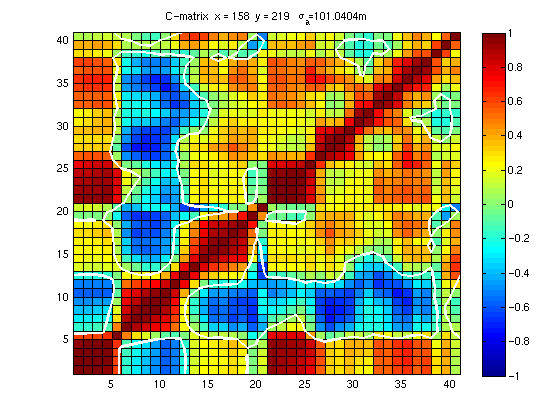Menu
Alison Fowler
Thesis: Assimilation of misplaced boundary layer features.
Department of Meteorology, University of Reading.
Supervised by Ross Bannister and Stefano Migliorini and by John Eyre at the Met Office.
Click here to download a copy of my thesis.
Summary
The importance of background error covariances
In the formulation of variational assimilation the specification of the
background error covariances play a key role.
They are responsible not only for how much weight should be given to the
background but also how the additional information
from the observations should be spread both spatially and to other variables.
The covariances can be stored in an N by N
matrix where N is the length of the background vector.
Issues in assimilating the boundary layer capping inversion
The assimilation of data when an inversion is present can be particularly difficult due to the complexity of the background errors.- The error correlations are highly flow dependent with a strong relationship to the height and structure of the inversion which can be very variable, especially over land.
- When a strong inversion is present the errors of the air above and below the inversion should be uncorrelated, see figure below. If the correlation length scales are too long then information obtained from the observations about background errors within the boundary layer are effectively 'leaked' into the free atmosphere air above which may degrade the final analysis.
- The background inversion height often has a large positional error. Due to the structure of the inversion an error in the background position can lead to a large difference in the temperature values given by the background and observations. This can make it difficult to find an estimate of the true state of the atmosphere (analysis) which is consistent with both the background and observations. Often the resulting analysis ends up losing the inversion structure. Increasing the background temperature errors in the region of the inversion would allow the background to become more consistent with the observations although it is desirable to maintain information about the background inversion structure.
 |
When a positional error is present it becomes clear that the amplitude (level by level) errors are no longer Gaussian. This breaks down a key assumption made in variational data assimilation. However it is possible to stay in the Gaussian framework if the errors are separated into a positional and amplitude error. The development of this scheme was the focus of my PhD.
More information.
- Fowler, A., Bannister, R., Eyre, J.: A new floating model level scheme for the assimilation of boundary layer top inversions: The univariate assimilation of temperature. Q. J. R. Met. Soc., 138, 682-698.
- Fowler, A., Bannister, R., Eyre, J., 2010: Characterising the background errors for the boundary layer capping inversion. Austral. Meteorol. Ocean. J., 59 , 17-24.
- Fowler, A., 2010: Assimilation of misplaced boundary layer features. Ph.D. Thesis. Uni. Reading